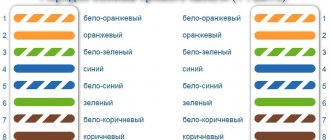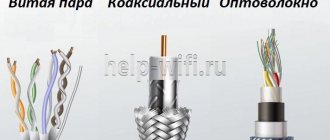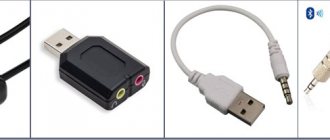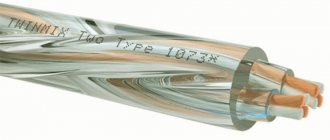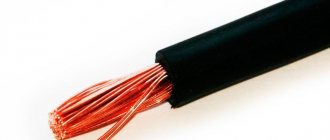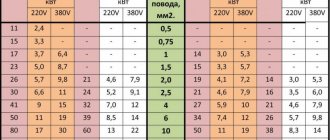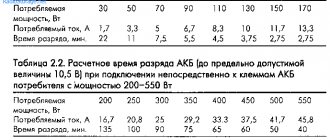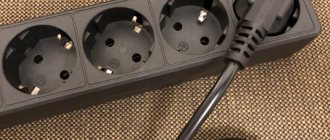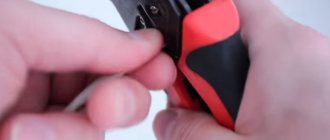Author of the article
Yuri Sanaev
System Administrator. Sales manager of computers and wi-fi equipment. Work experience – 10 years. Knows everything and even more about hardware and software.
To bring the Internet into the house, lay a local network, or connect a computer to a router, a special wire is required. To choose a good Internet cable, you need to know what types there are, what tasks they are intended to solve, and what characteristics they have.
Types of network cables for the Internet
The list of main types of network cables:
- coaxial;
- fiber optic;
- twisted pair
The design of a coaxial wire includes a conductor with a dense insulating coating, a copper or aluminum braid, and an outer insulating layer. In addition to connecting to the network, Internet products are used to translate signals from antennas and television satellites to build high-speed digital networks (cable TV).
RJ 45 pinout – Twisted pair crimping: diagrams, connection methods
The configuration of the wire connectors is different:
- The BNC connector is attached to the ends of the cable, providing connection to the T-connector and barrel connector.
- BNC barrel connector is designed for connecting damaged elements or extending the wire to expand the range of the network or connect additional electrical equipment.
- A BNC T-connector is a tee used to connect computer equipment to the main network line. The wire has 3 connectors (1 is intended for output to a centralized network, 2 connectors are necessary for connecting a local system).
- The BNC terminator is designed to act as a ground plug, preventing the signal from propagating outside the local line. The connector is required for stable operation of network connections that occupy a large area.
To create local lines, a twisted pair network cable is used. The products include pairs of twisted copper conductors with an insulating layer. A standard wire consists of 4 (8 conductors) or 2 pairs (4 cores). According to standards, there should be no more than 100 m between devices connected by cable. The wire is available standard or with protection. To work with the cable, an 8P8C connector is used.
Before choosing a twisted pair Internet cable, you need to determine the subtype based on the characteristics of the outer layer (thickness, presence of reinforcement, composition). The UTP wire with a plastic outer layer is not protected and is produced without grounding. F/UTP, STP, S/FTP products are manufactured with shielding.
Twisted pair cable markings reflect categories based on the color of the insulating layer:
- gray (used in the interior spaces of buildings);
- black (used to designate products coated to protect against precipitation and electromagnetic radiation, used for outdoor structures);
- the orange hue is used to indicate non-flammable polymer compounds.
Fiber optic cable is an improved wire for building network lines. The product consists of plastic fiberglass light guides with plastic protection. Cable products are characterized by high speed of information transfer and are resistant to line interference. The wire can connect systems over long distances. Products are divided into single-mode and multimode.
Fiber optics use different types of connectors (FJ, ST, MU, SC). The wires are inexpensive, look aesthetically pleasing, but require the purchase of additional equipment and are difficult to install. The products are used to form large-scale network systems and create access to the Internet at high speed.
Copper conductors in an Ethernet cable are produced:
- whole;
- twisted.
Solid conductors are strong, reliable, durable, but less flexible. The products are intended for stationary indoor systems or short installations on external structures. Stranded products consist of thin copper wires twisted together. The cables are durable, flexible, and are designed for placement in work spaces and in places where objects need to be moved.
How to crimp a LAN cable?
Crimping a LAN cable requires a special tool, but if you don’t have one, you can get by with a screwdriver. Step-by-step instructions for crimping a cable with pliers look like this:
- Trim the sheath a few centimeters to make it easier to straighten the wires. They can be straightened with pliers or scissors.
- After straightening, trim the wires again to 1 cm.
- Insert the LAN cable into the RJ-45 connector.
- Place pliers into the connector and crimp the cable with them.
- Set up a router or PC so that the local network starts working.
Types of twisted pair cable
What kind of twisted pair cable is needed to connect to the Internet? Twisted pair cables are divided into types:
- monolithic;
- stranded;
- shielded;
- unshielded.
Monolithic (one core) is used for laying in the walls of a building and installation to the terminal equipment of a communication line, for example, to an information socket on one side (apartment) of the communication channel equipment (provider). It is not intended for connecting network devices due to the impossibility of bending due to the single thick core.
Multi-core twisted pair cable is an ideal solution for connecting devices (computers, routers, TVs, switches, printers) and connecting them to an Ethernet socket. The small diameter of the cores allows you to bend and twist the cable as required when connecting devices in the apartment.
It is impossible to use stranded twisted pair wire in an information socket for two reasons:
- The wires break easily when screwed into the connector.
- Signal attenuation in multi-core twisted pair cables occurs at a distance of more than 100 meters.
There are several types of twisted pair cable shielding, which are clearly visible in the photo.
For laying cable in an apartment, a four-pair U/UTP solution is sufficient. UTP or U/UTP means that security is not provided. The F prefix or simply FTP means that there is one external common screen wrapped around four pairs.
Marking
Labeling an internet cable on it is a good way to understand what the wire is.
Marking example: NetLink PVC CAT5E UTP 4Pair 24 AWG.
Explanation:
- NetLink - manufacturer;
- PVC – PVC braid;
- Cat5E – category 5E;
- UTP – without shielding;
- 4Pair – 4 pairs;
- 24 AWG – section type.
Another example: Cabeus FTP-4P-Cat.5e-SOLID-OUT
Explanation:
- Cabeus – manufacturer;
- FTP – foil protection;
- 4P – 4 pairs;
- 5e – category 5e;
- Solid – one core;
- OUT – for outdoor installation.
Thus, knowing the characteristics of an Internet cable, you can understand from the markings on its outer shell what it is and whether it is suitable for the user’s tasks.
Coaxial wire
The very first cable created for connecting the Internet. Patented in 1880, used for transmitting high frequency signals. In modern times it is rarely used, but it is impossible to completely exclude it.
The device looks like this:
- It consists of a central conductor.
- The conductor is surrounded by a dense layer of insulation.
- Next comes copper or aluminum braiding.
- The outside is covered with a rubber insulating layer of several millimeters.
It is divided into two types: thick and thin. Each variety is used depending on the application environment. The specificity of such a wire is increased flexibility and speed of signal attenuation. Therefore, the transmission speed is not designed for long distances, reaching a maximum of 10 Mbit/s.
Nowadays the coaxial type is not used for the Internet due to its too low speed. The only area of application is cable television. However, it is also gradually disappearing, as modern routers allow the installation of wireless television.
Types of Internet cable connectors for coaxial wire represents a large collection consisting of:
- A BNC connector installed at the ends of a wire to connect to other connectors.
- BNC T-shape. This is a tee to connect the device to the main line. Contains three connectors, one of which is required for a network card.
- A Barrel-type BNC is required if the connection between trunks is broken or the length needs to be increased.
- BNC terminator. This is a plug that blocks the propagation of the signal. Two grounded terminators are required for the network to function properly.
About wired and wireless technologies
Modern manufacturers of computer equipment and peripherals, as well as mobile phones, are gradually replacing cable transmission of data and electricity with wireless.
Prominent examples of this trend include wireless headphones and chargers. Wireless data transfer protocols wi-fi and bluetooth have become widespread.
It is quite possible that a point in time will soon come when computers and other electronic devices located at great distances from each other will communicate with each other using wireless data transfer protocols.
However, now, for the local computer network and peripheral devices to computers, ordinary cables are used. Below we will tell you about their types and features.
To connect computers on a local network or to connect them to a global network, a network cable is used.
Benefits of fiber optics
Fiber optic cable is a special wire made of glass and plastic. Thanks to it, the beam is transmitted using its reflection. There are single-mode and multi-mode cable fibers. In the first case, the beam propagates in one copy, and in the second case, in multiple copies, when each beam (mod) is introduced into the cable at a certain angle. Data transmission using this technology was first carried out in the 1950s.
What are the differences between 3G and 4G networks: features, advantages and disadvantages. Among the features of this type of wires, the following can be identified, which are also advantages of the technology:
- Fiber optic lines are not affected by electromagnetic waves and fields, which means that in any conditions you can fully experience the good quality of communication and its reliability;
- The data transmission speed over optical fiber is high-speed. This makes it possible to exchange information many times faster than via any type of iron wires;
- The absence of electromagnetic radiation, which makes it possible to increase the security of this type of data transmission. Optical cables cannot be used for wiretapping. To do this, you need to completely destroy its structure, which will be noticed by low signal speed and various types of interference;
- Due to the technology used, the cables do not require a large number of relay points, which reduces internal interference when transmitting binary information.
Mistakes made during compression
Incorrect sorting before crimping the core by color. Some unscrupulous manufacturers make the color of the braiding of each wire very dull, so many people in low light confuse the white-green pair with the white-blue pair. Be careful.
Each conductor in the connector must be fully inserted. Carefully check that all the tips are visible.
It is necessary that the protective sheath of the twisted pair inserts 0.5 mm - 0.7 mm into the connector. When crimping, it is also pressed, making it much more difficult to pull out the wires when pulling them out of the laptop socket.
Keep in mind that the crimper does not last forever, and over the years it begins to crimp more and more often with defects. Connectors are also divided into good quality and bad, so it is better to take proven ones and not skimp. Even an experienced installer who knows how to crimp a twisted pair cable will make a lot of mistakes with such a tool.
Why twisted pair?
Several types of Internet cables are used in the network infrastructure:
- Coaxial – used in radio communications, automation systems, security systems, video surveillance and television broadcasting. It works on the principle of transmitting radio frequency electrical signals.
- Fiber optic - used to transmit information over vast distances at a higher speed than in radio-electronic communications. It works on the principle of transferring light within itself, using total internal reflection.
- Twisted pair - used in cable systems, telecommunications and computer networks. It works on the principle of connecting two nodes and using separate media to transmit information in different directions.
A twisted-pair cable consists of several pairs of insulated conductors, twisted together with their own twist pitch, covered with polypropylene or polyethylene insulation. If the cable is of high quality (more on this below), the insulation consists of foamed polyethylene and Teflon. This protects against high dielectric losses and during operation at elevated temperatures.
Additionally, twisted pair cable of the fifth category can use a protective shield against electromagnetic interference, and also use a “breaking thread” for the convenience of tearing the insulation when pulling, and for protection against tearing. The core of the conductor is a monolithic copper core (0.4-0.6 mm) or several pairs of cores in a bundle.
Due to its low cost and ease of installation, twisted pair cable is widely used to equip office and apartment buildings with local networks and the Internet.
At the ends of the wire, an 8P8C plug is used (popularly the name of the RJ45 standard has stuck, which is a little incorrect) to connect network devices in local LAN networks, that is, computers, routers, switches, hubs and others.
It is easy to recognize the purpose of the cable by the color of the insulation:
- black – adapted to the influence of external factors (air, dampness);
- orange - indicates the resistance of the insulation material to high temperatures and combustion;
- light gray - used for laying inside buildings, houses, apartments, offices.
Checking the quality of the compression performed
After any work performed, it must be checked. What are we going to do now?
The first method is a cable tester
We buy a cable tester that can determine the quality of the wire, the quality of the Internet cable crimp, and detect breaks. Due to all these problems, the Internet on the PC will not work. It's easy to figure out how to use it. We don't think you'll need instructions either. But you will have to spend some money.
The second option is a multimeter
Most owners have a regular tester in their home. We set the “ringing” function and begin ringing each color at the two ends of the cable.
The third method is to connect the device with other devices
After crimping, a direct connection must be made. We plug one end into the computer’s network card, and the other can be inserted into a router or switch. How to connect and configure a router, read our other article. If everything is fine, then the red cross on the network adapter will disappear on the PC, and the LED on the router will light up. If there is no router or switch, then you can connect two computers directly.
Internet connection using fiber optic
The most widespread Internet in the Russian Federation, the network of which operates on the basis of optical fiber, is provided by the provider Rostelecom. How to connect fiber optic internet?
First you just need to make sure that the optical cable is connected to the house. Then you need to order an Internet connection from your provider. The latter must provide connection data. Then you need to configure the equipment.
It is done like this:
- After installing the optical fiber and connecting the equipment that ensures operation in optical passive networks, the provider’s employees perform all subsequent configuration independently.
- First of all, install the yellow cable and socket as shown in the figure below.
- You can have your own Wi-Fi router; you don’t have to purchase a router from Rostelecom. Wi-Fi is connected to a fiber optic cable, an optical terminal and a main cord, through which the router is connected to an optical outlet.
- It is necessary to choose the most ventilated place possible for installing all equipment. The installer from the provider company should indicate exactly where the network elements need to be installed.
The terminal is equipped with a special socket that allows you to connect to a computer and connect the router to the Internet. In addition, the terminal has 2 additional sockets that allow you to connect an analog home telephone to a fiber-optic connection, and several more sockets are provided for connecting television.
LAN cable splitter
This element is used to increase the length of lines and organize cable inserts. The signal quality is not lost when using them. A LAN cable splitter for the Internet allows you to connect two PCs to the network via one cord. To do this, you need to install a network card on both devices and connect them via a switch. A well-known splitter model, RJ45, will help connect both PCs. To connect, you will need to go to the network and sharing management section, select the desired network connection and, opening properties, join the “TCP/IPv4 Internet Computer Protocol” network.
What types of veins are there?
Several core options are used in network wires:
- copper;
- copper-plated
Types and categories of optical fibers and cables. Singlemode and multimode
By type and purpose, single-mode and multimode optical fibers (as well as cables consisting of them) are distinguished.
- Single-mode fiber optic threads transmit only 1 light signal (one mode). The diameter of their core is 7-10 microns (in communication systems - 9 microns), and the narrower it is, the lower the dispersion and the less attenuation of the beam. The bandwidth of a single-mode cable is lower than that of a multimode cable, but it is capable of transmitting data over longer distances.
- Multimode fibers carry multiple signals simultaneously. Their cores have a cross section several times larger - 50-62.5 microns, which creates conditions for increasing the level of dispersion and faster pulse attenuation. These types of cables are designed for relatively short distances.
Fiber optic cables, which are used to build computer networks, are divided into 7 classes:
- OS1 is a single mode with a 9 micron core.
- OS2 is a broadband single mode with a 9 micron core.
- OM1 is a multimode with a 62.5 µm core.
- OM2 – multimode with a 50 µm core.
- OM2 plus – momomod with a 50 µm core for laser sources (improved).
- OM3 is a high-speed multimode with a 50 micron core.
- OM4 is an optimized multimode with a 50 µm core.
Single-mode cables are designed for long-distance intercontinental, interstate, intercity and intracity backbones (usually 10 km or more), as well as for connecting remote equipment nodes of telecommunications companies and data centers. That is, they are used where continuity (or a minimum number of connections) and increased line reliability are important.
Cables of this type are cheaper than multimode ones, but if you take into account the costs of the entire necessary set of equipment, then systems using single-mode transmission are more expensive.
Multimode cables are used to connect workstations and other end devices indoors to a network, for communication between floors and nearby buildings (up to 550 m). They are also used to equip additional communication lines in data centers.
To connect to the Internet, residents of multi-storey buildings most often use multimode cables of the OM3 and OM4 classes.
Fiber optic cables transmit data over distances of up to 40-100 km and support speeds of up to 100 Gbit/s. But these are only theoretically achievable values: the speed and quality of communication is affected by the category of cable and the equipment that processes the signal.
Number of cores
Twisted pair cable can be produced with 4 and 8 cores. To transfer according to the standard at speeds of up to 100 Mbit/s, you can use 4 cores, but to get more than 100 megabit/s - 1 Gbit/s, you will need all 8 cable cores.
Therefore, it is necessary to find out in advance what the Internet speed is in the apartment in order to select the correct number of twisted pair cable cores.
Products are also produced:
- single-core;
- stranded.
How to check if a LAN cable is working?
First you need to check if the connection is present. To do this, go to “Network Connections”. If there is no connection, you can diagnose the correct operation of the PC’s network card and update drivers. To check the functionality of the network card, you need to find the “Device Manager” in the “Control Panel”, which contains a section with network cards. If the icon next to the selected board lights up, it's all about it.
To quickly find out whether the cord is broken, you can purchase a LAN cable tester. Before doing this, it makes sense to visually check the cable for damage and poor crimp quality. If problems cannot be found, a tester will help. The most popular model right now is the Tester MicroScanner Pro.
So which is better - optics or copper twisted pair?
Nowadays, any large and even medium-sized Internet provider uses optical fiber in a number of segments of its networks. And vice versa: no matter how the provider lures you with a connection to the “fastest new generation system,” certain sections of its networks are traditional copper cable. It’s just that the rules are dictated by environmental conditions (in some places they are more suitable for copper, and in others for optics) and economic feasibility, and marketing is marketing.
No one can say for sure what type of highway the providers “The Bronze Horseman” and “Optical Illusion” connected your home to, so we will assume that their offers differ only in the way they connect subscribers inside apartments.
The table below compares the properties of fiber optics and twisted pair:
| Optical fiber | Copper twisted pair | |
| Theoretically achievable communication speed | OS1 – 40 Gbps OS2– 100 Gbit/s OM3 and OM4 – 100 Gbit/s | Up to 10 Gbps for Category 6 and 7 cables. |
| Maximum continuous line length | OS1 – 100 km OS2 – 40 km OM3 – 300 m OM4 – 125 m. | 100 m |
| Physical properties of the cable | Thin, fragile | Thick, flexible |
| Exposure to external influences | Excessive bending, pressure, certain types of radiation | Electromagnetic interference, atmospheric electricity, corrosive chemical environments, fire, unauthorized connection to read data |
| Compatibility with client equipment | Requires the purchase of special adapters | Compatible with any device equipped with RJ-45 jacks |
| Service | Requires special equipment and training | Requires minimal skills and knowledge |
| Price | High | Low |
Let's summarize:
- A fiber optic line is up to 10 times faster and has a much longer range than twisted pair, it is not affected by interference from electrical equipment and power lines, is durable and strong, does not burn, and does not lose its properties from moisture, acids and alkalis. Does not allow spy tapping or eavesdropping via inductive connection.
- A fiber-optic network is easier to disguise in the interior; it does not require the installation of wide, unaesthetic cable channels.
- Fiber optics is, although flexible, glass, and any glass can crack and crumble. Therefore, installation and modernization of such a network requires great care. If damaged twisted pair can be cut and connected by simple twisting, then to restore broken optics you need a special welding machine and the ability to handle it. And sometimes even minor damage to a fiber optic line requires its complete replacement.
- The main advantage of twisted pair is its low cost and ease of use. Most likely, you will not be charged any extra money for connecting to the Internet via a copper cable, but you will have to pay for optics, because they are expensive. A twisted pair cable with a universal connector can be immediately plugged into a computer - and the Internet will appear on it. For optics, you will again have to fork out for a special socket, modem (ONT terminal or router), and network adapters. And this is also not cheap.
Purely fiber optic networks inside houses and apartments are still very rare; most often they are made hybrid - partly optical, partly copper wire, partly wireless. The optics are usually connected only to the modem, and the end devices - computers, smartphones, smart TVs, etc. receive the Internet over the same twisted pair cable or Wi-Fi, because they are not equipped with light signal decoding modules. This means that no matter what super speeds your provider promises you, slow network segments will reduce it to nothing.
So, your choice is “The Bronze Horseman” if:
- You don't want to overpay for something you probably won't get. If your devices that consume Internet traffic operate on outdated Ethernet or Wi-Fi protocols, then optics will not make them faster.
- You often move your computer from place to place, you have a dog that likes to chew wires, or small children who grab everything. And if the cable is damaged, it’s easier for you to fix it yourself than to pay a technician.
It is better for you to become a client of Optical Illusion if:
- You are for everything new against everything old. Fiber optics is the technology of the future and therefore worthy of investment. And even if it is not friendly with every device, we can expect that soon the manufacturers of the latter will come to their senses and equip their products with fiber-optic support. After all, consumers want this and are ready to invest.
- Finances are not a problem for you. You have modern technology that supports the latest wired and wireless communication protocols, and you are ready to make it “take the maximum height.”
- You need speed and that's it.
- Network security in terms of possible data leakage is your everything.
What criteria should you use to choose a cable?
Of all types of network cables for carrying the Internet in an apartment, office or home, it is better to choose twisted pair cable of category 5E. When purchasing, you need to pay attention to a number of criteria, otherwise a bad wire will cause a weak signal and constant loss of communication.
Category
There are 7 categories of wire in total.
- Categories 1, 2, 4 are almost never used. Type 3 is selected for telephone lines.
- Categories 5 and 5e have almost no differences; the fifth is actually not on sale. Since 2010, after the advent of 5E, manufacturers, practically without changing the Internet cable, began to apply this particular category to the shell. It is she who is the most popular today.
- In category 5E there is a 2-pair (4-core) or 4-pair (8-core) cable with data transmission up to 100 and 1000 Mbit/s. Also, a four-pair cable is laid for networks with a speed of 1 Gbit/s. The maximum allowable distance for it is 100 meters.
- Category 6 consists of four pairs and is intended for networks with speeds up to 10 Gbit/s. For speeds up to 1 Gbit/s, the maximum wire length is 100 meters, for speeds up to 10 Gbit/s – 55 meters.
- Categories 6a, 7 and 7a are shielded cables for networks with speeds up to 10 Gbit/s and highways up to 100 meters. The use of such a screen means increased requirements for equipment and installation (good grounding is required), so most often the use of fiber optics is preferred over this wire.
| Category | Frequency, MHz | Signal transmission rate, Mbit/s |
| 5 | 1-100 | 10, 100 |
| 5e | 1-100 | 10, 100, 1 Gbit/s (eight-core cable) |
| 6 | 1-250 | 10, 100, 1 Gbit/s |
| 6a | 1-500 | 10, 100, 1 Gbit/s, 10 Gbit/s |
| 7 | 1-600 | 10, 100, 1 Gbit/s, 10 Gbit/s |
| 7a | 1-1000 | 10, 100, 1 Gbit/s, 10 Gbit/s |
It must be remembered that the category only reports on the quality of the Internet cable.
It is mistakenly believed that changing the wire will change the frequency at which it operates. This is not true. The cable operates at the frequency of the network equipment. Replacing a high-quality fifth category with a sixth will not increase the signal speed and communication status.
Core type
Depending on the type of core, a WLAN wire can be single-core or multi-core. In the first case, there is one thick vein inside. It bends poorly and is used for installing Internet sockets. Stranded wire has many thin strands. This Internet cord bends easily, is convenient to install and is used to connect different devices indoors. For example, you can connect a cable of this type to the LAN connector of your router, run it to the PC and insert it into the network card.
According to the material of manufacture, the cores can be copper or copper-plated. The first type is more reliable, suitable for networks up to 50 meters long. The second type is cheaper, its core is an inexpensive vein. It has weak conductivity, so it is coated with copper on top. The current passes through the copper part, which means that the conductivity is practically not reduced.
When choosing, you need to take into account that the wire can be of two types - CCS and CCA. The first has a steel core, the second has an aluminum core. Steel is more difficult to install and is brittle. Aluminum is almost no different from copper, but is afraid of long distances.
Shielding
The shield protects the Ethernet cable from external interference and dampens radiation from the pairs themselves. It can be general for all couples or personal for each couple.
The following varieties are known:
| Designation according to ISO/IEC 11801 | General screen | Screen for individual couples |
| U/UTP | – | – |
| U/FTP | – | Foil |
| F/UTP | Foil | – |
| STP | Braid | – |
| SF/UTP | Braid, foil | – |
| F/FTP | Foil | Foil |
| S/FTP | Braid | Foil |
| SF/FTP | Braid, foil | Foil |
A cable connected to a router or used to lay a network around an apartment, usually of the UTP type. Shielded types are suitable for placing the wire in the same corrugation or groove with an electrical cable, when laying the line in close proximity to electrical wiring, as well as when installing outdoors.
Section
Another standard to pay attention to is AWG or wire gauge. The lower this value, the thicker and better quality the cable. UTP 5e twisted pair cables typically use AWG24. In categories 6 and 7 - AWG 23 and 22.
Comparison of optical fiber and twisted pair
The Ethernet cable, which is widely used for wiring a wired local network, consists of copper wires. Providers cannot switch completely to fiber optics - compared to LAN cables, fiber optics are afraid of bends. Therefore, ordinary copper patch cord is still successfully used in network infrastructure (especially in home and office solutions).
I advise you to read about twisted pair in even more detail. And of course about Wi-Fi.
But, as for the characteristics of the cable itself, here is a visual table.
| Characteristics | Optical cable | Twisted pair (copper) |
| Achievable communication speed (theory, without interference), Gbit/s | OS1 – 40 OS2 – 100 OM3/OM4 – 100 | Cat 5e – Up to 1 Cat 6/7 – Up to 10 |
| Line length without repeaters (theory), km | OS1 – 100 OS2 – 40 OM3 – 0.3 OM4 – 0.125 | Any cable up to 0.1 |
| Physical properties | Fragile (afraid of bending), thin | Flexible (you can bend corners), thick |
| Equipment (compatibility) | Requires special adapters (PON port) | Works with any equipment with a LAN port |
| Service | Requires training and special equipment | Can be serviced at home |
| Price | Bites | Tolerant |
As for external influences, the connected optical fiber is not afraid of:
- Power pickups;
- Fire;
- Moisture;
- Temperature changes;
- Acidic and alkaline environments;
- “Line listening” due to ignoring inductive influences.
5) A good Ethernet cable has a fire-resistant sheath
Typically, the sheath of an Ethernet cable can consist of two types of materials: non-flammable and fire-retardant casing. Fire-resistant cables are designed to prevent fire from spreading to a new area, while non-flammable cables cannot. Therefore, for safety reasons, it is better to buy cables that do not propagate combustion. In addition, fire-resistant types and grades are worthy of consideration. There are many types of fire retardant cables, such as CM, CMR, CMP, LSZH, etc. Generally, CM and LSZH PVC sheathed Ethernet cables are commonly used in cable environment. If you need to use cables in a return air booster system, you should use CMP (Plenum Cable) in ductwork or air handling equipment. For more details, you can check the Ethernet cable cover rating.
Copper or partially copper-plated cable
When choosing a wire, the length of the network and the number of connected objects are taken into account. At short distances, the difference in products made of copper or copper-plated is insignificant. When conducting networks longer than 50 meters in copper-plated wires, signal transmission failures occur. The conductivity of aluminum alloy and steel is lower than copper.
Products made of copper alloys are intended for the construction of large-scale local systems with a distance between objects of up to 10-20 meters. The products do not interfere with signal transmission. To connect a computer to tees, sockets, and switching equipment, cores with a combined composition (copper-clad) are sufficient.
The video below clearly shows the differences between a copper FTP core of a twisted cable and a copper-clad aluminum UTP.
Adapter for LAN cable
Sometimes it becomes necessary to extend the cable or restore its damaged section. A LAN cable pass-through connector (or adapter) is a block for ensuring contact between the cable cores. Different models of this mini-adapter are used in different situations. If it is necessary to connect two cables with connectors at the ends, purchase a block with connectors. If you need to connect two ends of the cable, use a block without connectors. Using adhesive tape, you can quickly make a connection without stripping the wire of insulation.
Internet cable laying
The first thing we strongly advise you to do is to lay a cable channel with a diameter of at least 2.5 centimeters from the landing into the apartment. Many owners, wanting to provide themselves with uninterrupted Internet, turn to two or even three or four local providers at once.
And imagine that each of them will drill your wall in order to stretch their cable inside the apartment. But your home may also have cable for television and landline telephone! Let there be one cable channel so that all the wires enter the apartment in one place, without unnecessary holes in the wall.
“Why do I need to run a network cable (twisted pair) throughout my apartment?” - you ask. I’ll put a powerful router in the hallway, where the provider introduced the cable into the house and that’s it, Wi-Fi is guaranteed! And no worries. Yes, a router won’t hurt you in any case to use the Internet on your smartphone. But if the apartment is large, the walls are reinforced concrete, and there is interference from neighbors’ Wi-Fi, problems will arise.
Alternatively, you can create a network of two or three routers installed in different places in the apartment. But, again, you will have to run an Internet cable to them if there is no “bridge” or repeater function. In addition, wired Internet is still more reliable and faster than wireless Internet, as proven by the experience of numerous users.
Therefore, decide exactly where your computer and laptop will be located in your apartment. It is possible that you have several of them - each family member. Choose the optimal place to stretch the Internet cable (twisted pair) where you need it. If major renovations in the apartment are not yet planned, then you can hide the cable under the baseboard or behind the ceiling space. This is what is often done in offices.
If you are still doing major repairs, then it is advisable to lay the Internet cable in grooves along the walls or under the floor screed. In this case, you must be guided by the following rules:
- Never place network, telephone, antenna and other low-current cables in the same groove, parallel to 220 Volt power lines! It is unacceptable! If it so happens that there is no other possibility, low-current cables can intersect with power cables at right angles. But it is better to avoid such a situation. The distance between the power supply cable and the low-current twisted pair must be at least 20 centimeters; this is a norm that must be adhered to;
- Under plaster and screed, it is recommended to lay the Internet cable in a corrugated pipe to ensure insulation and avoid strong bending and stress;
- The maximum length of the Internet cable from one point to another is 80 meters. Consider this point when choosing a location for your home computer;
- Avoid kinking the cable or bending it excessively. If you need to turn a twisted pair cable and bring it into the room from the corridor, the bending radius should be at least 8 outer diameters of the cable;
- The cable fixation points in the grooves should be at a distance of about 50 centimeters;
- The cable is fixed with clamps, brackets, and other snap-on fasteners;
- Crimping of a network cable is always carried out only with special tools.
Always purchase an Internet cable, twisted pair cable of appropriate quality, UTR5 standard. If you don’t know what to choose, consult with specialists or representatives of your provider.
When the Internet cable has already been laid, it needs to be connected to a network outlet or connectors. Be sure to leave a small margin of cable length so that you can easily connect it. The installation boxes will be the same as for conventional sockets and switches, which the Rmnt.ru portal wrote about in detail. Here it is already allowed to locate an Internet outlet next to a power outlet; they are even combined into one group of installation boxes with a common frame.
In general, laying an Internet cable is no more complicated than ordinary wiring of electricity throughout an apartment. And if you can’t handle it yourself, contact specialists.
What is better to connect to the apartment for the Internet?
When providers offer to connect home Internet, they often talk about the cable they use. Usually it comes down to the fact that it is a good cable and works better than others. Let's look at the fact of what the difference is for an ordinary subscriber.
Most often, apartment buildings are connected using two technologies: Fast Ethernet or GPON.
Fast Ethernet - connection using a cable - 4-wire twisted pair, which passes up to 100 Mbit/s. If you need more speed, then connect an 8-core twisted pair cable, which passes up to 1 Gbit/s.
GPON - connection using a fiber optic cable that passes up to 1 Gbit/s.
Let's look at the differences between technologies on the most important points for the user:
- The need to connect additional equipment;
- Freedom to choose a Wi-Fi router;
- Difference in connection speed;
- Cable strength.
Visually, the cables differ slightly in thickness, but not significantly. The Fast Ethernet cable is usually light gray and the GPON cable is yellow.
The cable from Fast Ethernet can be immediately connected to the device, but additional equipment is required for optical fiber
At first glance, there is no difference: in any case, a cable is installed in the apartment. If it is Fast Ethernet, then the cable is connected directly to a computer or laptop, or to a Wi-Fi router.
With GPON it is more difficult. Such a cable cannot be immediately connected to a computer; it requires a “converter” - a subscriber terminal. At the exit from the terminal there is the same twisted pair cable, which is connected to the subscriber’s device. It is important that the subscriber terminal is provided by the provider - you cannot use another one if the company’s equipment does not suit you. The terminal is another element in the network that can fail and, therefore, increases the risk of connection problems.
Freedom to choose a Wi-Fi router
With Fast Ethernet, you can choose any router model, regardless of brand, price and technical specifications.
When connecting GPON, the provider can provide a subscriber terminal with built-in Wi-Fi function. That is, by default you install the model provided by the provider. Or you will have to connect an additional router, for which you need to allocate space and an outlet.
Connection speed difference
Both twisted pair and optical fiber transmit speeds up to 1 Gbit/s
For an ordinary Internet user, 100 Mbit/s is enough: for social networks, watching videos and news, so there is no point in connecting GPON. If a subscriber needs a speed of more than 100 Mbit/s, then they use an 8-core twisted pair cable - this technology is called Gigabit Ethernet.
GPON allows you to transmit speeds up to 1 Gbit/s over a distance of 5-6 km. One cable is not enough for speeds up to 1 Gbps: the Wi-Fi router and your devices need to pass this speed.
Which cable is stronger?
Fast Ethernet pair cable is stronger than fiber optic
The strength of Fast Ethernet and GPON cables is different and this is due to their “filling”. Inside the Fast Ethernet cable are copper wires that can be bent and laid into the baseboard. Even if you accidentally crush the cable under a sofa leg or door, the Internet can still work. With a Fast Ethernet cable, you can remove the damaged section and connect the cable without losing speed.
There are glass fibers inside the GPON cable that cannot be bent at an angle of 90% - this will immediately lead to loss of communication. If you accidentally damage such a cable in one place, then to restore it you will have to lay a new one throughout the apartment. Lengthening or shortening the optical fiber will also not work - usually providers offer to immediately change the cable.
How to connect Good Line
Good Line connects Fast Ethernet in the apartment, because it is easier to use and is capable of transmitting more than 100 Mbit/s. In addition, the Fast Ethernet cable is easy to repair, lengthen or shorten at the request of the subscriber, unlike GPON.
Good Line also uses GPON cable, but only when connecting over long distances: between cities and houses.
In short:
1. The twisted pair cable can be immediately connected to a computer, laptop, or Wi-Fi router. For fiber optics, you must install a subscriber terminal that is powered from the network.
2. With twisted pair cable, you can choose any router model. When connecting fiber optics, you will have to use Wi-Fi, which is built into the subscriber terminal, or install your own router and then you will have two set-top boxes.
3. Optical fiber is suitable for connecting private homes, when several kilometers of cable need to be laid from the main equipment to the subscriber. Twisted pair is not capable of transmitting speed over a distance of more than 100 meters, but optical fiber copes with this perfectly.
4. Both twisted pair and optical fiber are capable of carrying speeds of more than 100 Mbps. But optical fiber is easier to damage, and when restoring it, you need to change the cable throughout the apartment. Twisted pair is stronger in everyday life, and even if the cable is damaged, a separate segment can be restored without complete replacement.
Wiring after repair
Running an Internet cable through an apartment after renovation is more difficult. Mainly because you will have to move the furniture and lay it out so that it does not get in the way and is not conspicuous. There are two options here:
- Modern skirting boards have channels for multiple cables. Open them one at a time and route the wires inside the baseboards to their destination. There will be problems with doorways; you will have to lead directly or around the door.
- Cable channels. Buy small cable channels, raise them to the ceiling or hide them behind furniture. Then run all the wires through them. More work, but it will turn out nicer than hanging wires.
Types of conductors
Wire is made from different materials with different thicknesses. And the price greatly depends on their quality and cross-section.
Material
Copper is considered the canonical metal for wire. But it is quite expensive in itself, and is not always needed for use. Therefore, at the moment you can see three main materials:
- Aluminum. A wire made of aluminum is much lighter and cheaper than copper. These are all its advantages, then there are only disadvantages. The electrical conductivity of aluminum is 1.7 times lower than that of copper. In small areas this is not noticeable, but in long areas bordering on the maximum permissible lengths it can become a serious problem. Connectors may slip off aluminum wires over time. The material is highly susceptible to corrosion and its use is unacceptable in damp rooms or outdoors, since due to corrosion damage the electrical conductivity of the core is significantly deteriorated. Aluminum wire is not as flexible as copper wire, so it is somewhat more difficult to install and easier to damage. The ideal place to use a cable with aluminum conductors is a dry room, for example, an apartment or office, where the cable length does not exceed half that allowed by the standard used. This cable will not power devices using PoE (Power over Ethernet) technology. This technology allows signal and power to be transmitted to the device through this wire;
- Copper-plated aluminum. It is an aluminum cable with a copper layer applied to its surface. This cable is also much lighter than copper, but not so cheap. The difference with copper cable is about 15%. The advantage over pure aluminum cable is improved electrical conductivity and corrosion protection. But even though the conductivity is already much better than that of aluminum, PoE technology does not work well on such a cable;
- Copper. Wire made from copper is heavier and more expensive than all others. But it is precisely this that allows you to squeeze out everything that is intended from the technology used. And it is with the copper version that the throughput of the twisted pair will be maximum. A network built from copper cable will be of the highest quality and most durable.
Conductor design
Conductors can be single-core or multi-core.
- Single-core (Solid). It is a solid core of one conductor. Suitable for transmitting signals over long distances. Suitable for crimping with hand tools;
- Stranded, consists of several conductors twisted in a spiral. More flexible and well suited for making patch cords. Not very suitable for crimping with hand tools.
Section
The thicker the cross-section of the twisted pair core, the more information can be passed through it, and the higher the transmission range. The division into categories already implies that the required wire cross-section will be maintained for the selected cable category. To mark the conductor cross-section, a marking was invented - AWG. This abbreviation is translated into Russian as – American wire gauge. To put it simply, each AWG value has its own core diameter and cross-sectional area. For single-core and multi-core cables these values will be different.
For Cat.5e the standard is 24AWG. This means that for it to work properly, the diameter of each wire must be 0.511 mm, which means a cross-sectional area of 0.205 square meters. mm.
What is UTP 5E cable
The UTP designation means nothing to the average user. In fact, this is an abbreviation for “Unshielded twisted pair”, that is, “unshielded twisted pair”. This means that the cores do not have a shielding braid, which is not needed under normal conditions. It is only required if there are high-voltage power cables nearby that create a lot of interference. This cable has a fifth category, as the name suggests, and is capable of operating at frequencies up to 100 MHz. Twisted pair cable of the sixth category is distinguished by a large cross-section of wires and can operate at frequencies up to 250 MHz, but is used much less frequently - when it is necessary, for example, to connect very distant computers or to organize a high-speed network.
Press for LAN cable
The tool for crimping the cord is called a press. With its help, you can quickly and efficiently crimp a LAN cable. It’s worth understanding what it is and how to choose the right press. The tool is officially called a “crimper,” but models vary in functionality and size. For example, some crimpers remove insulation from wires or trim untwisted conductors before crimping. When choosing a tool, weight and appearance are important (it should be weighty and free of any bends or dents on the body), and its elements should be placed evenly in relation to each other.
